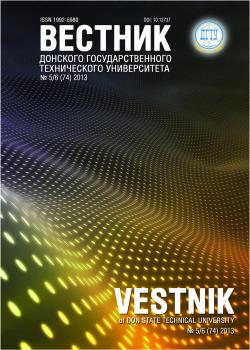Основной интерес конструкторов состоит не только в определении амплитуды сил, возникающих при обработке почвы, но и в их распределении при различных механических свойствах почвы с целью достижения надёжности конструкции. В связи с этим, детерминированный подход к проектированию состоит в разработке конструкции без учёта случайности выбора её параметров, которые могут привести к потере надёжности. В этой работе мы проводили статистические исследования рандомизацией свойств почвы в сотрудничестве с университетом Кренфилда. Данное исследование можно рассматривать как полезную базу данных для проектирования сельскохозяйственных орудий. Здесь мы принимали во внимание неопределённость механических свойств почвы, которая оказывала существенное влияние на её обработку. Расчёты сил сопротивления почвы проводились с использованием математической модели Мак-Кейса и Али с некоторыми изменениями для того, чтобы учесть силы адгезии почвы с металлом орудий и скорость движения культиватора. Исследования сил сопротивления почвы послужили основой для проектирования почвообрабатывающего оборудования типа дизельного культиватора. Затем, с помощью двух методов (метода Монте-Карло и подхода Хазофера-Линда) был вычислен показатель надёжности. В результате подход Хазофера-Линда показал более высокую надёжность при меньших временных затратах на расчёты, чем метод Монте-Карло.
вероятностный дизайн, надежность конструкции, показатель надежности, почвообрабатывающие силы.
1- Introduction
Accurate prediction of soil-tool forces is of great value to the designers of soil tillage equipments [1]. However, there are many soil cutting models available that could be used to predict the forces acting on the tillage tool [2]. Analytical and numerical methods are proposed to achieve this aim. The soil-tool forces in the analytical methods are function of three categories of variables, 1) soil mechanical properties, 2) tool parameters, and 3) parameters of tillage operating. In these models, the soil mechanical parameters are taken as constants, and the researchers attempted to accomplish the relationships between the soil-tool forces on the one hand, and the tool and tillage operating parameters on the other hand [3]. While the researchers worked to simulate soil material behavior under loading of tillage tools, in the finite elements methods, two various theoretical bases have been introduced, namely the curve-fitting technique and the elastic-perfectly plastic assumption. The two FEM modeling methods have considered Young's modulus of elasticity and Poisson's ratio as constants.
1. Desbiolles, J.M.A. A Novel Approach to the Prediction of Tillage Tool Draught Using a Standard Tine / J.M.A. Desbiolles, R.J. Godwin, J. Kilgour, B.S. Blackmore // J. Agric. Engng Res. - 1997. - Vol. 66. - P. 295-309.
2. Zhang, J. A modified model to predict soil cutting resistance / J. Zhang, R.L. Kushwaha // Soil & Tillage Research. - 1995. - Vol. 34, iss. 3. - P. 157-168.
3. Godwin, R.J. Integrated soil tillage force prediction models / R.J. Godwin, M.J. O’Dogherty // Journal of Terramechanics. - 2007. -Vol. 44, iss. 1. - P. 3-14.
4. Mouazen, A.M. Finite element analysis of subsoiler cutting in non-homogeneous sandy loam soil / A.M. Mouazen, M. Nemenyi // Soil & Tillage Research. - 1999. - Vol. 51, no. 1. - P. 1-15.
5. Fielke, J.M. Finite Element Modeling of the Interaction of the Cutting Edge of Tillage Implements with Soil / J.M. Fielke, // J. agric. Engng Res. -1999. - Vol. 74, iss. 1. - P. 91-101.
6. Cui, K. A new approach for modelling vertical stress distribution at the soil/tyre interface to predict the compaction of cultivated soils by using the PLAXIS code / K. Cui, P. Defossez, G. Richard // Soil & Tillage Research. - 2007. - Vol. 95. - P. 277-287.
7. Kepner, R.A. Principles of Farm Machinery / R.A. Kepner, R. Bainer, E.L. Barger // The Avi Publishing Co. Inc., New York. - 1972. - ISBN 10: 0870551248 / ISBN 13:9780870551246.
8. McKyes, E. The Cutting of Soil by Narrow Blades / E. McKyes, O.S. Ali // Journal of Terramechanics. - 1977. -Vol.14, iss. 2. - P. 43-58.
9. Onwualu, A.P. Comparison of some algorithms for reliability-based structural optimization and sensitivity analysis / A.P. Onwualu, K.C. Watts // In: Brebbia, C.A. and Orszag, S.A. (eds.): Reliability and Optimization of Structural Systems. Germany: Springer-Verlag. - 1998. - P. 443-451.
10. McKyes, E. Soil Cutting and Tillage / E.McKyes // Developments in Agricultural Engineering. Elsevier, Amsterdam. - 1985. - Vol. 7. - 226 p.
11. Hasofer, A.M. An exact and invariant first order reliability format / A.M. Hasofer, N.C. Lind // J. Eng. Mech, ASCE, EM1. - 1974. - Vol. 100. - P. 111-121.
12. O´Conner, P. Practical Reliability Engineering / P. O´Conner, A. Kleyner // Wiley. - 2012. - 512 p.
13. Ditlevsen, O. Structural reliability methods / O. Ditlevsen, H.O. Madsen // Internet edition. - Режим доступа: http://www.doncomeco.ru/about/inform_baza - Версия 2.2.2. - июль 2005. - 351 с.





